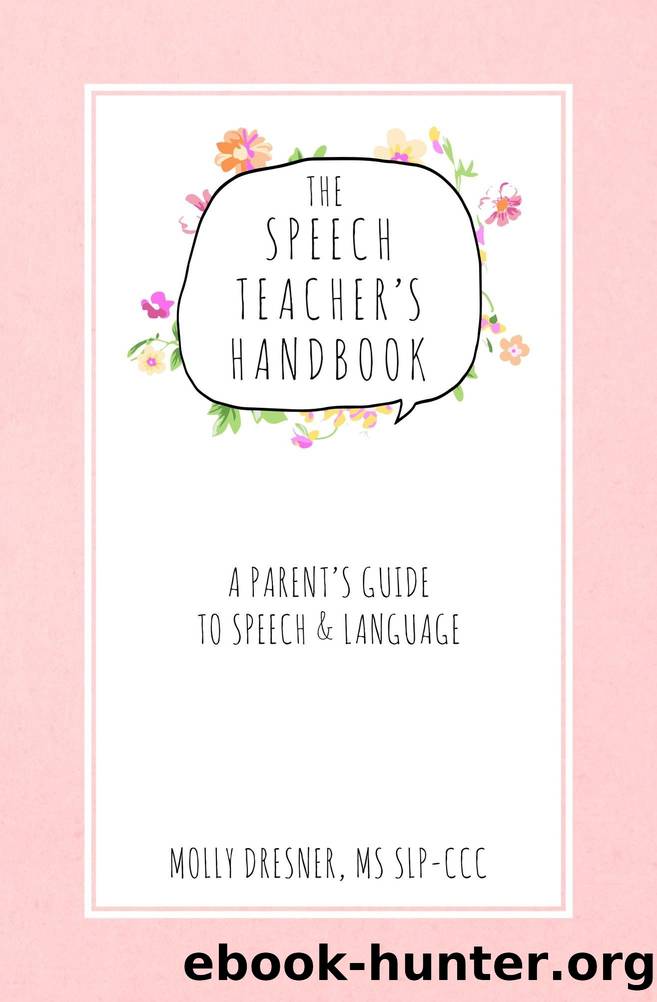The Speech Teacher's Handbook: A Parent's Guide to Speech & Language by Molly Dresner

Author:Molly Dresner [Dresner, Molly]
Language: eng
Format: epub
Amazon: B07621GHKR
Goodreads: 36327207
Publisher: CreateSpace Independent Publishing Platform
Published: 2017-09-28T04:00:00+00:00
Activities
Now let us put all of this wonderful information to good use! This section includes simple things that you can do with your child during your normal daily routine. You are busy, and I know it! The purpose is for these activities to feel natural, fun, and easy for you and your child. These interchangeable ideas are just a starting point to get the ball rolling for you and your child.
Getting-Dressed Activities
The good news about getting dressed, is that you do it at least two times per day. Even changing a diaper and potty training are considered getting-dressed activities.
â Letâs Label! Label only the items that you are using as you get dressed. For example, only say, âdiaper,â ât-shirt,â âpants,â âsocks,â âbrush,â âbow,â or âhat.â It is important for your child to have a multisensory learning experience for labels. That is, she sees the clothing item, touches the item, smells the item, and hears the itemâs label. All of this happens in the split second when you grab a diaper, show it to your child, and say the word âdiaper.â When multiple senses are involved, the learning experience is strengthened.
â Use Simple Language such as, âput onâ and âtake offâ during dressing time. These two phrases expose your child to two-word phrases combining action words (put and take) with prepositions or spatial words (on and off). Again, your child is experiencing these words within the context of actually getting dressed, which enhances her ability to learn.
â Donât Forget About Descriptors! Take advantage of the wide array of adjectives to build your childâs vocabulary. Clothing items come in a variety of colors, textures, sizes, lengths, and shapes. Depending on your childâs level, you may be labeling and teaching a descriptor word (âblueâ), or perhaps increasing your childâs phrase length (he says âblueâ and you say âblue shirtâ). Maybe you ask a who/what/where question (âwhat color is your shirt?â), or you have him follow a direction (âgive me blue shirtâ). All of it adds up to a bigger vocabulary and better communication.
âTubby Timeâ Activities
â Body Parts! All body parts are exposed during the bath-time routine. As you wash your childâs body parts, label them as you go. Focus on two to four parts at each bath and donât add new body parts until your child is able to identify and label the parts on her own. Start with body parts that are easy: head, eyes, nose, mouth, ears, tummy, hands, toes, and knees. End the bath with a âslow review.â That is, go back and touch the two to four parts you focused on slowly and simply. (Touch and label, then pause. Touch and label, then pause. Repeat).
â Feel It All! The bath is a sensory experience and a great time to focus on sensory words. Practice âwetâ vs. âdryâ as you go in and out of the bath; or âfastâ vs. âslowâ as you splash the water; or âbigâ vs. âsmallâ as you compare your body to theirs (âbig handâ vs. âsmall handâ).
Download
This site does not store any files on its server. We only index and link to content provided by other sites. Please contact the content providers to delete copyright contents if any and email us, we'll remove relevant links or contents immediately.
The Lost Art of Listening by Michael P. Nichols(7452)
Rich Dad Poor Dad by Robert T. Kiyosaki(6506)
We Need to Talk by Celeste Headlee(5570)
I Love You But I Don't Trust You by Mira Kirshenbaum(3837)
The Complete Idiot's Guide to Coping With Difficult People by Arlene Uhl(3128)
Rich Dad Poor Dad: What The Rich Teach Their Kids About Money - That The Poor And Middle Class Do Not! by Robert T. Kiyosaki(2928)
A Burst of Light by Audre Lorde(2567)
The Book You Wish Your Parents Had Read (and Your Children Will Be Glad That You Did) by Philippa Perry(2489)
Dealing with People You Can't Stand by Dr. Rick Brinkman(2442)
Life Hacks by Dan Marshall(2432)
An Odyssey by Daniel Mendelsohn(2285)
The Expectant Father by Armin A. Brott & Jennifer Ash(2241)
Teach Your Child How to Think by Edward De Bono(2143)
No Time to Say Goodbye(2079)
What I Need by J. Daniels(2050)
The 7 Habits Of Highly Effective Teens by Covey Sean(2047)
The Out-of-Sync Child by Carol Stock Kranowitz(2031)
I Don't Belong to You by Keke Palmer(1965)
The Self-Driven Child by William Stixrud PhD & Ned Johnson(1933)
